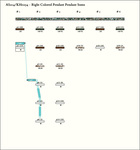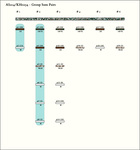| Notes: |
Ascher Databook Notes:
- Construction Note: Cords 1 and 2 are linked through the twisted end of the main cord so that they dangle from the end
of the main cord.
- Construction Note: Several cords are kinked just at the place where a knot cluster is expected as if knots were present but had been untied. Because the color and texture of the cords are unmarred, any unknotting would not have been recent. The kinks are sufficiently clear to be able to "reconstruct" the number and type of knots. In no case does an actual knot cluster appear on a kinked cord at the level of the kink. The listing contains the actual knots only. Both the "reconstructed" knots (marked with *) and the actual knots are shown below. No values are imputed to them as we do not know whether to combine them or replace one with the other.
| Cord | Knots {no,. type. position} |
|---|
| 5 | *1s (8.0); 4L (19.5) |
| 9 | 1s (7.0); *2L (18.5) |
| 13 | 1s (6.5); *2L (15.5) |
| 14 | 1s (6.5); * 1E (14.5) |
| 15 | 1s (7.0); *3L (15.0) |
- By spacing the khipu is separated into a pair of dangle end cords and five groups of pendants. The first two groups have six pendants each and the same color pattern LB:TG, LB, LB:W, W, W, W. The last three groups have two pendants each and their colors are subsequences of the six-color pattern (LB:TG, LB:W or LB, W).
- The values on the dangle end cords are related. to the values of the pendants in group 1. The value of cord 1 is the sum of the first three pendant values in the group. Also, the color of cord 1 (LB) appears alone or in combination on the three pendants. The value of cord 2 is the sum of the remaining three pendant values in group 1. Cord 2 and these three pendants are all W.
- The values on the three consecutive W pendants in group 2 are double the values on the three consecutive W pendants in group 1. Their order, however, is reversed. That is:
2*P1j = P2,7-j for j=(1,2,3)
|









